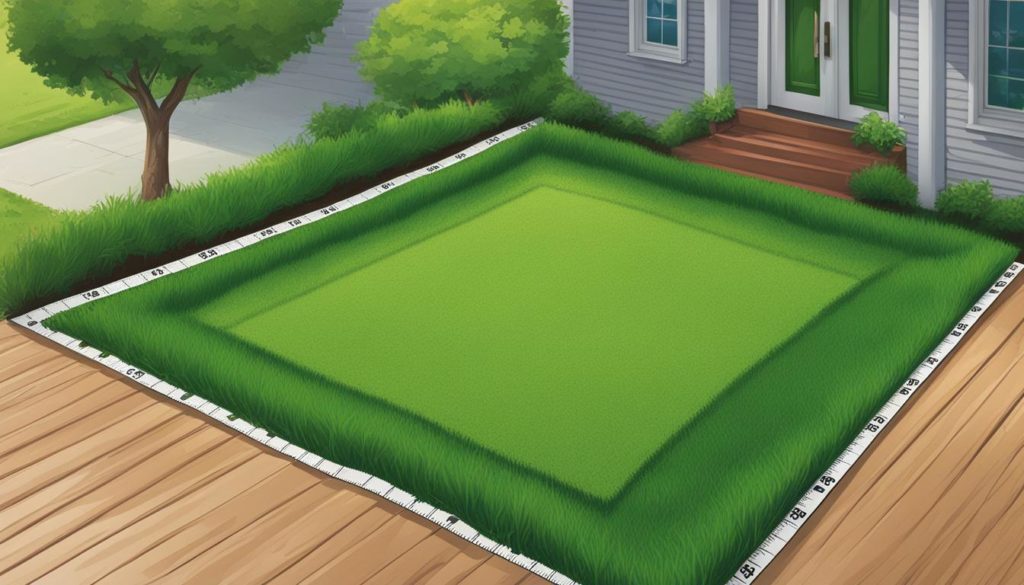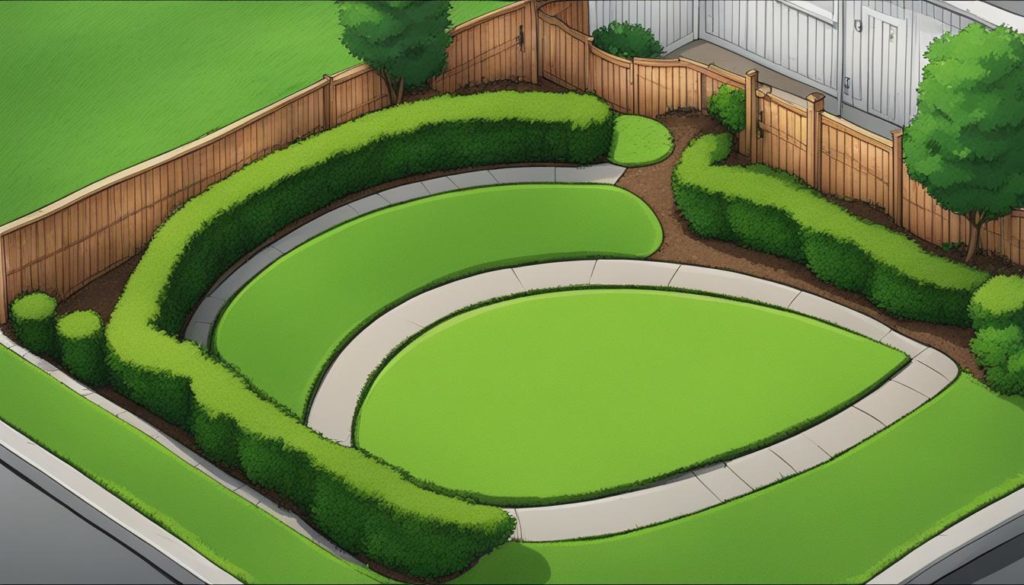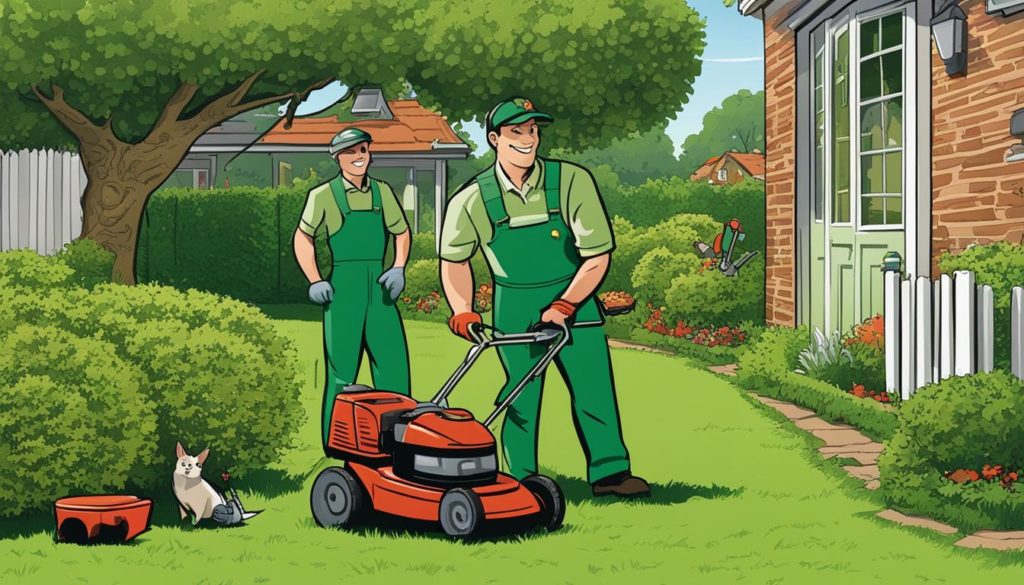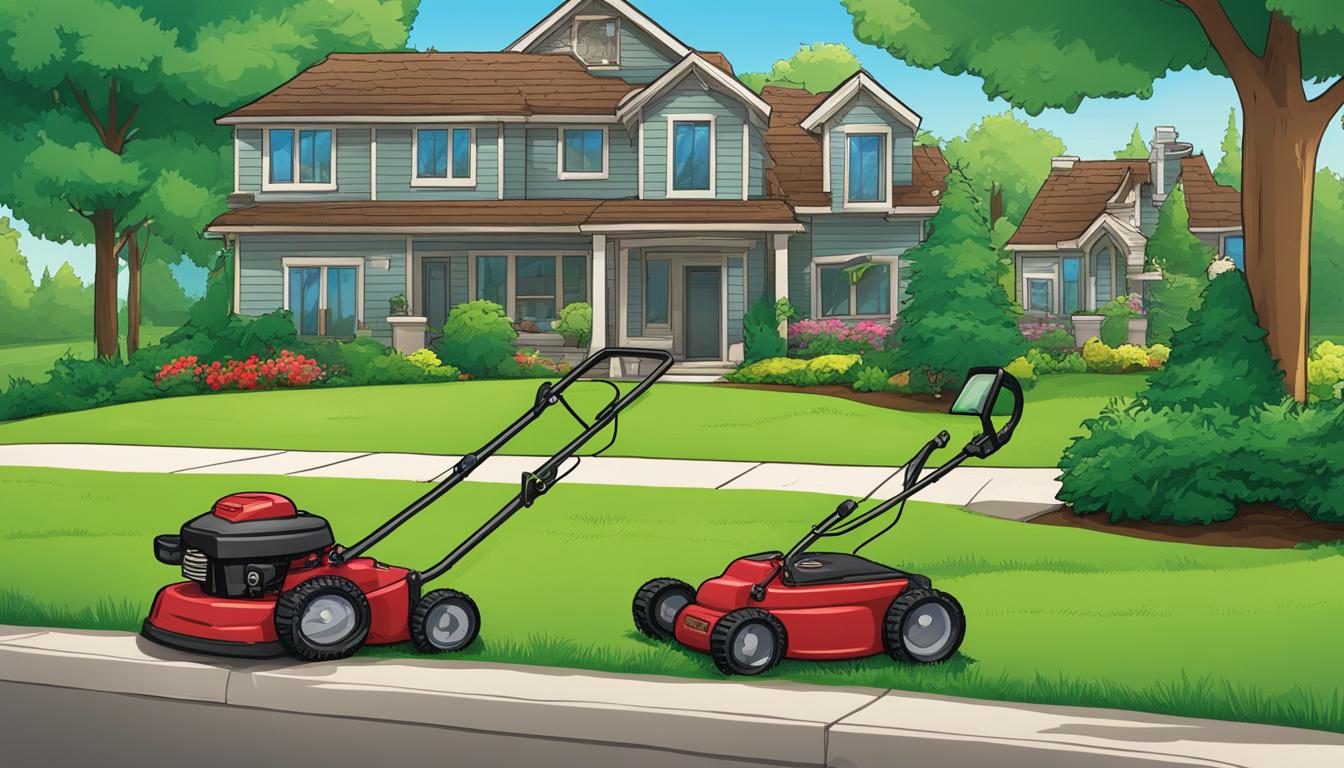Are you wondering why lawn care services come with a hefty price tag? Many factors contribute to the high cost of lawn maintenance. From the history and cultural significance of lawns in American society to the labor and equipment required for upkeep, understanding the reasons behind the expense can help you make informed decisions about your lawn care needs.
In this article, we will explore the various factors that affect the cost of lawn care services. We will delve into the size and shape of the lawn, the type of services needed, accessibility, frequency of maintenance, and geographic location, all of which play a role in determining the overall cost. By uncovering the truth behind expensive lawn care, you can find alternatives that fit your budget without compromising the health and beauty of your lawn.
Key Takeaways:
- There are multiple factors that contribute to the high cost of lawn care services.
- The history and cultural significance of lawns in American society play a role in the perceived value and expense of lawn care.
- The size, shape, and accessibility of your lawn, as well as the type and frequency of services needed, can all impact the cost of lawn care.
- Understanding the breakdown of costs can help you explore affordable alternatives for maintaining your lawn.
- By considering factors such as lawn size, service type, and geographic location, you can manage lawn care costs effectively.
The Importance of Lawns in American Society
In American society, lawns hold a significant amount of importance and are seen as more than just patches of grass. They have become a symbol of social status, adding to the curb appeal of properties and potentially increasing property values. Well-maintained lawns are seen as a reflection of the American Dream of homeownership, showcasing pride and dedication to one’s property.
Lawns are also subject to maintenance regulations imposed by homeowner associations to ensure that community standards are upheld. Failure to maintain a lawn can result in fines and can impact the perception of the homeowner within the community. The appearance of a well-manicured lawn is seen as a reflection of the homeowner’s commitment to their property and the overall neighborhood aesthetic.
“Lawns provide an opportunity for homeowners to demonstrate their pride in their homes, elevate their social status, and contribute to the overall beauty of their communities,” says landscaping expert Jane Davis.
The Impact on Social Status and Property Values
Lawns play a role in how individuals are perceived within society. A lush, healthy lawn is often associated with success, wealth, and a high social standing. It can create a positive impression on visitors, neighbors, and potential homebuyers, making the property more attractive. Many homeowners invest in professional lawn care services to maintain the pristine appearance of their lawns and uphold the image they wish to project.
| Importance | Benefit | |
|---|---|---|
| Curb Appeal | Enhances the overall appearance of the property. | Increases the chances of attracting potential buyers and raising property values. |
| American Dream | Reflects the desire for homeownership and the pursuit of a better life. | Symbolizes the achievement of the American Dream. |
| Community Standards | Contributes to the maintenance of a visually appealing and cohesive neighborhood. | Ensures that property values are safeguarded within the community. |
Overall, lawns play a vital role in American society, representing more than just grass and plants. They have become a symbol of social status, a reflection of the American Dream, and a means of enhancing curb appeal and property values. The maintenance and care of lawns are regulated to ensure that communities maintain a cohesive aesthetic and that homeowners take pride in their properties.
The History of Lawns in America
The history of lawns in America dates back to the early Native American civilizations, who altered the landscape for their hunting and fishing needs. However, it was European colonization that brought about significant changes in landscaping practices. The colonists introduced imported grasses from their native lands to create pastures for their livestock, which quickly spread across the continent.
As the country grew and urbanization took hold, the popularity of lawns increased. In the late 19th century, the lawn care industry began to emerge, offering services to maintain these growing expanses of grass. With the advent of specialized equipment and the development of lawn care techniques, the industry continued to evolve and flourish.
“The lawn care industry has come a long way since its humble beginnings. From the Native Americans’ alterations to the landscape to the influence of European colonization, lawns have become an integral part of American society.”
Today, lawns are an essential part of the American landscape, with millions of acres devoted to green spaces. They serve not only aesthetic purposes but also provide recreational areas for families and contribute to the overall beauty of communities. The history of lawns in America is a testament to the ever-changing relationship between humans and the natural environment.
| Native American Landscape Alterations | European Colonization | Imported Grasses | Growth of Lawn Industry |
|---|---|---|---|
| Native Americans shaped the land for hunting and fishing needs. | European colonists introduced imported grasses for livestock. | Imported grasses quickly spread across the continent. | The lawn care industry emerged and evolved over time. |
Factors Affecting Lawn Care Costs
When it comes to lawn care costs, several factors come into play that can influence the overall price you pay for professional services. Understanding these factors can help you make informed decisions and manage your expenses effectively. Here are the key factors that affect lawn care costs:
Lawn Size
The size of your lawn is one of the primary factors that can impact the cost of lawn care services. Larger lawns generally require more time and effort to mow, fertilize, and maintain, which can result in higher costs. Some companies charge based on the square footage of the lawn, while others may have different rates for smaller and larger properties.
Lawn Shape
The shape of your lawn can also affect the cost of lawn care services. Lawns with irregular shapes or obstacles such as trees, fences, or playground structures may require additional time and effort to mow and maintain. This extra labor can lead to higher costs compared to lawns with straightforward shapes and easy accessibility.
Type of Service
The specific services you require for your lawn will also impact the overall cost. Basic lawn mowing services are typically the most affordable option, while additional maintenance services such as fertilizing, weed control, and mulching can increase the total cost. Be sure to discuss the specific services you need with the lawn care professional to get an accurate estimate.
Labor Costs and Service Frequency
The cost of labor is another factor that can contribute to the overall cost of lawn care. Highly experienced and skilled professionals may charge higher rates for their services. Additionally, the frequency of lawn care services, such as weekly or bi-weekly maintenance, can affect the cost. More frequent services may come at a higher price due to the increased labor and time required.
Grass Length and Type
The length and type of grass in your lawn can also impact the cost of maintenance. Longer grass may require extra time and effort to mow and trim, leading to higher costs. Similarly, certain grass types may require specialized care or specific equipment, which can influence the overall price you pay for lawn care services.
Accessibility and Geographic Location
The accessibility of your lawn and your geographic location can also affect the cost of lawn care services. Lawns that are difficult to access, such as those with limited entry points or located on steep slopes, may require additional labor and equipment, resulting in higher costs. Moreover, the cost of living and market rates for lawn care services can vary depending on your geographic location.
| Factor | Impact on Cost |
|---|---|
| Lawn Size | Higher cost for larger lawns |
| Lawn Shape | Additional cost for irregularly shaped lawns or those with obstacles |
| Type of Service | Additional cost for maintenance services beyond basic mowing |
| Labor Costs and Service Frequency | Higher cost for experienced professionals and more frequent services |
| Grass Length and Type | Extra cost for longer grass or specialized care for certain grass types |
| Accessibility and Geographic Location | Higher cost for difficult-to-access lawns or areas with higher cost of living |
By considering these factors, you can have a better understanding of what influences the cost of lawn care services. It’s always a good idea to communicate your specific needs and requirements to lawn care professionals, allowing them to provide accurate estimates based on your unique situation.
Cost Breakdown of Lawn Care Services
When it comes to the cost of lawn care services, several factors come into play. Understanding the breakdown of these costs can help you make informed decisions about your lawn care needs. Let’s take a closer look at the different elements that contribute to the overall cost:
Lawn Mowing Costs
Lawn mowing is one of the most common services needed to maintain a healthy and beautiful lawn. The cost of lawn mowing services typically ranges from $30 to $80 per week, depending on the size and complexity of your lawn. Factors such as grass length, obstacles, and any additional services provided can also impact the price.
Additional Maintenance Services
In addition to lawn mowing, there are other maintenance services that you might require to keep your lawn in top shape. These services can include fertilizing, weed control, aeration, and more. The cost of these additional services varies depending on the specific needs of your lawn and the frequency of the services required.
For a comprehensive breakdown of the costs, refer to the table below:
| Service | Price Range |
|---|---|
| Lawn Mowing | $30 – $80 per week |
| Fertilizing | $50 – $100 per application |
| Weed Control | $50 – $150 per treatment |
| Aeration | $75 – $200 per session |
| Additional Services | Varies depending on the service |
Lawn Size and Labor Costs
The size of your lawn can also impact the overall cost of lawn care services. Larger lawns require more time and effort to maintain, which can result in higher labor costs. Additionally, factors such as lawn shape and accessibility can also affect the price. It’s important to discuss these aspects with your lawn care provider to get an accurate estimate for your specific situation.
In conclusion, the cost of lawn care services depends on various factors such as lawn mowing costs, additional maintenance services required, lawn size, lawn shape, and labor costs. Understanding these costs and discussing them with your lawn care provider will help you make informed decisions about the best ways to care for your lawn while managing your budget effectively.
Lawn Size and Its Impact on Costs
The size of your lawn plays a significant role in determining the cost of lawn care services. Companies may charge based on square footage or have different rates for smaller and larger properties. On average, the cost per square foot starts at around $0.02, but this can vary depending on various factors.
For larger properties, the cost is typically calculated differently, such as per acre. The average cost per acre for lawn care services ranges from $150 to $300. Larger properties may see smaller incremental increases in cost compared to smaller ones. It’s important to note that these prices are estimates and can vary depending on your specific location and the services required.
Understanding the cost breakdown based on lawn size can help you plan and budget accordingly. Here is an example of a table showing a cost breakdown per square foot for a lawn:
| Lawn Size (in Square Feet) | Cost per Square Foot | Total Cost |
|---|---|---|
| 1,000 | $0.02 | $20.00 |
| 2,000 | $0.02 | $40.00 |
| 3,000 | $0.02 | $60.00 |
Please note that this is just an example, and actual costs may vary. It’s always best to consult with lawn care professionals to get an accurate quote based on your specific lawn size and needs.

Average Lawn Care Cost per Acre
If you have a larger property, you may be wondering about the average cost per acre for lawn care services. Here is an example of a table showcasing the cost breakdown per acre:
| Lawn Size (in Acres) | Cost per Acre | Total Cost |
|---|---|---|
| 1 | $250 | $250 |
| 2 | $250 | $500 |
| 3 | $250 | $750 |
Again, keep in mind that these are just examples, and actual costs may vary. It’s always recommended to get a personalized quote from lawn care professionals to accurately determine the cost based on your specific lawn size and requirements.
Impact of Lawn Shape on Costs
The shape of your lawn can have a significant impact on the costs of lawn care services. Lawns that have irregular shapes or include obstacles such as trees, fences, or playground structures require more time and effort to mow and maintain. This additional time and effort can result in higher costs for lawn care professionals.
When calculating the cost of lawn care services, professionals take into account the complexity of the lawn shape and the obstacles present. For example, a lawn with a simple rectangular shape will generally be easier and quicker to mow compared to a lawn with irregular edges or intricate landscaping. The presence of obstacles also requires careful navigation and attention to detail, which can contribute to higher costs.
It’s essential to communicate your lawn’s shape and any obstacles to the lawn care professional when requesting a quote. This information will allow them to assess the level of difficulty and provide an accurate estimate of the cost. Additionally, they may offer suggestions or recommendations on how to minimize costs or overcome challenges related to the lawn’s shape and obstacles.

Table: Impact of Lawn Shape on Costs
| Lawn Shape | Difficulty | Cost |
|---|---|---|
| Rectangular or Square | Easy | Affordable |
| Irregular | Moderate | Higher |
| Complex or Intricate | Difficult | Highest |
As shown in the table above, lawn shape directly correlates with the difficulty of maintaining the lawn and the associated costs. An irregular lawn shape can make mowing more time-consuming and require additional precision to ensure an aesthetically pleasing result. On the other hand, complex or intricate lawn shapes present the greatest challenge, involving meticulous maneuvering around multiple obstacles and intricate landscaping features.
By understanding how the shape of your lawn impacts costs, you can plan and budget accordingly. It’s also worth considering design changes or landscaping adjustments that may simplify the shape of your lawn and reduce future maintenance costs. Ultimately, open and transparent communication with lawn care professionals will help ensure accurate cost estimates and efficient services.
Types of Lawn Care Services
When it comes to maintaining your lawn, there are various types of services available to suit your landscaping needs. Understanding these different options can help you make informed decisions and create a beautiful outdoor space. Here are the three main types of lawn care services:
1. Softscaping
Softscaping involves the installation of plants and foliage to enhance the natural beauty of your lawn. This includes planting grass, trees, shrubs, flowers, and other greenery. Softscaping can transform your yard into a vibrant and visually appealing outdoor space.
2. Hardscaping
Hardscaping focuses on non-horticultural elements to create functional and appealing features in your lawn. This can include the installation of patios, walkways, retaining walls, fire pits, or water features. Hardscaping adds structure and design to your outdoor area, creating a unique and inviting space to enjoy.
3. Xeriscaping
Xeriscaping is a type of landscaping that focuses on water-efficient design, particularly suitable for arid climates. It involves using drought-resistant plants, efficient irrigation systems, and mulch to minimize water usage while still creating a beautiful and sustainable landscape.
By understanding the different types of lawn care services available, you can choose the ones that best meet your aesthetic preferences and environmental needs. Whether you opt for softscaping, hardscaping, or xeriscaping, a well-maintained lawn is sure to enhance the overall look and feel of your outdoor space.
| Types of Lawn Care Services | Description |
|---|---|
| Softscaping | Involves the installation of plants and foliage to enhance the natural beauty of your lawn. |
| Hardscaping | Focuses on non-horticultural elements to create functional and appealing features in your lawn. |
| Xeriscaping | Focuses on water-efficient design, using drought-resistant plants and efficient irrigation systems. |

Softscaping adds life and vibrancy to your lawn, while hardscaping combines functionality with aesthetic appeal. Xeriscaping is an excellent choice for water-conscious homeowners. Depending on your preferences and the specific needs of your lawn, you can choose one or a combination of these services to create a unique and beautiful outdoor space.
Hidden Costs of Landscaping
When it comes to landscaping projects, it’s important to be aware of the potential hidden costs that can arise. These additional expenses can catch homeowners off guard if they are not properly prepared. Understanding these hidden fees and considering them in your budgeting process will help you avoid any financial surprises along the way.
One common hidden cost is travel expenses. If you live outside of a contractor’s service range, they may charge extra for the additional travel time and mileage. This is particularly relevant for larger landscaping projects that require specialized expertise. It’s always a good idea to inquire about any travel fees upfront to ensure you are budgeting accordingly.
Another factor to consider is equipment upkeep costs. Landscaping professionals rely on various tools and machinery to complete their work efficiently. Over time, these tools may require maintenance or even replacement, which can result in additional costs. While these expenses are typically covered by the contractor, it’s important to be aware that they may impact the overall price of your landscaping project.
Material and shipping costs can also contribute to hidden fees. Depending on the scope of your project, you may need to purchase plants, soil, rocks, or other materials. Additionally, if these materials need to be shipped to your location, you may incur additional charges. It’s important to factor these costs into your budget to ensure you have a clear understanding of the total expenses involved.
Lastly, the health and characteristics of your yard can impact the overall cost of landscaping. If your yard requires extensive preparation, such as removing old plants or addressing drainage issues, this can add to the overall price. Additionally, yards with unique features or challenges, such as steep slopes or difficult access points, may require specialized equipment or additional labor, resulting in higher costs.
Table: Common Hidden Costs of Landscaping
| Hidden Cost | Description |
|---|---|
| Travel expenses | Extra charges for contractors working outside their service range |
| Equipment upkeep costs | Maintenance or replacement of tools and machinery |
| Material and shipping costs | Purchasing and shipping of plants, soil, rocks, or other materials |
| Yard health and characteristics | Additional labor or equipment required for challenging or unique yard features |
Maintenance and Costs
Maintaining your landscaped yard involves various tasks that contribute to the overall cost of lawn care. Understanding the maintenance requirements and associated costs will help you plan and budget effectively. Here are some common maintenance tasks and their estimated costs:
Lawn Mowing
Mowing your lawn is a regular task that keeps it looking neat and tidy. The cost of lawn mowing services can range from $50 to $250 per visit, depending on the size of your yard and the complexity of the terrain. Factors such as grass length, obstacles, and accessibility can also impact the cost. It is recommended to schedule regular lawn mowing to maintain the health and appearance of your lawn.
Tree Trimming
Trimming trees in your yard is essential for maintaining their health and ensuring the safety of your property. The cost of tree trimming can vary widely based on factors like tree size, number of limbs to be trimmed, and the complexity of the trimming process. On average, tree trimming can cost between $300 and $700 per tree. It is advisable to consult with a professional arborist to assess the specific needs of your trees and provide an accurate cost estimate.
Yard Cleaning
Regular yard cleaning helps remove debris, leaves, and other unwanted elements from your lawn. The cost of yard cleaning services depends on the size of your yard, the amount of debris to be cleared, and the time required to complete the task. Estimates for yard cleaning typically range from $100 to $500, but prices may vary depending on your location and specific requirements.
In addition to these maintenance tasks, other services such as lawn aeration, fertilization, and weed control may be necessary for optimal lawn health. These services can be customized based on your specific needs and the condition of your lawn. Seasonal considerations, such as fall leaf removal or spring planting, may also impact the cost of maintenance services.
By understanding the costs associated with landscaping maintenance, you can develop a budget that aligns with your needs and priorities. Regular maintenance ensures the longevity and beauty of your landscaped yard, creating an inviting outdoor space for you and your family to enjoy.
Conclusion
Lawn care services can often be perceived as expensive due to various factors. The cultural significance of lawns in American society, along with the labor and equipment required for maintenance, contribute to the overall costs. Factors such as the size and shape of your lawn, the type of services needed, accessibility, frequency of maintenance, and geographic location can all impact the final cost of lawn care services.
By understanding these factors, you can make informed decisions and explore affordable alternatives for maintaining your lawn. Consider the size of your lawn and opt for services that best suit your needs. Additionally, look into local providers who offer competitive prices for the specific services you require. By doing so, you can manage your lawn care costs effectively while still enjoying a well-maintained lawn.
Remember, maintaining a lawn is not only about the cost but also about the pride and satisfaction that comes with it. A well-tended lawn can enhance the curb appeal of your home, increase property values, and contribute to the overall aesthetics of your neighborhood. So, take the time to assess your lawn care needs, factor in the costs, and find a balance that works for you.
Why go with Turbo Turf Landscaping for your lawn service needs?
Turbo Turf Landscaping is a family owned and operated full service lawn care provider. We proudly serve the East Orlando area including Avalon Park, Chuluota, Timber Springs, Waterford Lakes, Oviedo, and the UCF area. Our customer’s satisfaction is our number one concern as you should be able to enjoy your lawn in your free time. Please contact us at our Contact Us page (here) to receive a free estimate.
FAQ
Why is lawn care so expensive?
Lawn care can be expensive due to various factors such as the cultural significance of lawns, labor and equipment costs, and the size and shape of the lawn.
What factors affect the cost of lawn care services?
The size and shape of the lawn, type of services required, labor costs, grass length and type, accessibility of the lawn, frequency of service, and geographic location all play a role in determining the overall cost.
How does lawn size impact the cost of lawn care services?
The size of the lawn directly affects the cost of lawn care services. Some companies charge based on square footage, while others may have different rates for smaller and larger properties.
Does the shape of the lawn affect the cost of lawn care services?
Yes, lawns with irregular shapes or obstacles such as trees, fences, or playground structures require more time and effort to mow and maintain, leading to higher costs.
What are the different types of lawn care services available?
There are different types of lawn care services available, including softscaping (installing plants and foliage), hardscaping (non-horticultural elements like patios), and xeriscaping (water-efficient landscaping).
Are there hidden costs associated with landscaping?
Yes, hidden costs can include travel expenses for professionals working outside their service range, equipment upkeep costs, additional materials and shipping fees, and extra charges for yards with specific characteristics or health issues.
How much does lawn maintenance cost?
Lawn mowing typically costs between $50 and $250 per service, while tree trimming can range from $300 to $700 per tree. Other maintenance tasks have associated costs as well.
What can homeowners do to manage lawn care costs effectively?
By considering factors like lawn size, service type, and geographic location, homeowners can find ways to maintain their lawns while managing costs effectively.

